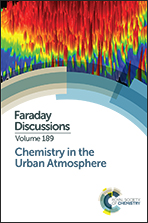The treatment of uncertainties in reactive pollution dispersion models at urban scales
Abstract
The ability to predict NO2 concentrations ([NO2]) within urban street networks is important for the evaluation of strategies to reduce exposure to NO2. However, models aiming to make such predictions involve the coupling of several complex processes: traffic emissions under different levels of congestion; dispersion via turbulent mixing; chemical processes of relevance at the street-scale. Parameterisations of these processes are challenging to quantify with precision. Predictions are therefore subject to uncertainties which should be taken into account when using models within decision making. This paper presents an analysis of mean [NO2] predictions from such a complex modelling system applied to a street canyon within the city of York, UK including the treatment of model uncertainties and their causes. The model system consists of a micro-scale traffic simulation and emissions model, and a Reynolds averaged turbulent flow model coupled to a reactive Lagrangian particle dispersion model. The analysis focuses on the sensitivity of predicted in-street increments of [NO2] at different locations in the street to uncertainties in the model inputs. These include physical characteristics such as background wind direction, temperature and background ozone concentrations; traffic parameters such as overall demand and primary NO2 fraction; as well as model parameterisations such as roughness lengths, turbulent time- and length-scales and chemical reaction rate coefficients. Predicted [NO2] is shown to be relatively robust with respect to model parameterisations, although there are significant sensitivities to the activation energy for the reaction NO + O3 as well as the canyon wall roughness length. Under off-peak traffic conditions, demand is the key traffic parameter. Under peak conditions where the network saturates, road-side [NO2] is relatively insensitive to changes in demand and more sensitive to the primary NO2 fraction. The most important physical parameter was found to be the background wind direction. The study highlights the key parameters required for reliable [NO2] estimations suggesting that accurate reference measurements for wind direction should be a critical part of air quality assessments for in-street locations. It also highlights the importance of street scale chemical processes in forming road-side [NO2], particularly for regions of high NOx emissions such as close to traffic queues.
- This article is part of the themed collection: Chemistry in the Urban Atmosphere

 Please wait while we load your content...
Please wait while we load your content...